Are you on the edge of choosing a tennis string but don’t know what to look out for? Or are you looking out for the property of tennis string that will give you the best value of money? If your answer is “Yes”, then you’re at the right place to find the explicit information that you need.
There are numerous strings flooding the market which make it hard to choose especially when you’re a beginner in tennis. Of a truth, even experienced players find it hard sometimes to get a suitable string for themselves. But having the fair knowledge of what makes up the content of the string and the property it should have for your skill level will be a helping hand in your selection.
In this article, I will be guiding you through the check marks needed for a string to be considered on a purchase. Money is hard to come by these days, so you don’t want to throw away the little that you have. Let’s move right to it.
The Material of Construction, The Principal determinant of Preference
The type of material used for the string forms a major part of the string’s quality. The kind of material used not only forms the bulk of the string but influences its playability as well as other properties. The wide range of strings available on the market is mostly made from nylon, polyester, aramid fibres and natural gut.
Natural Gut Based Strings – Ultimate Playability and Feel
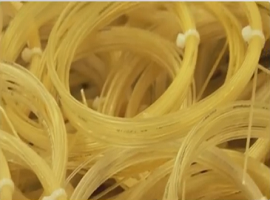 In the history of tennis when strings had not advanced like today, it was the number one choice among professionals in the ATP and WTP tours. As strings evolved, the demand for this material type has been in recession due to its cost since the modern technology has made it possible to develop low priced strings.
In the history of tennis when strings had not advanced like today, it was the number one choice among professionals in the ATP and WTP tours. As strings evolved, the demand for this material type has been in recession due to its cost since the modern technology has made it possible to develop low priced strings.
However, it’s unmatched with the others in terms of its playability, exceptional feel and maximum control without trading off the power. The natural gut strings are made from cow gut or sheep intestines with some advanced technology. To ensure longevity, it’s modified to have a weatherproof coating as a means of withstanding bad weather.
You might hesitate to buy a natural gut based string due to its cost, but if you have arm problems or simply want the best string, then that’s your best choice.
Nylon Based Strings: Is It Synthetic Gut or Nylon?
It’s common to come across synthetic guts when you make mention of tennis string since the best choice is in decline because of cost. Is it a different material? No, the synthetic gut is actually a nylon string. It can be soft or hard depending on its chemical composition.

Its solid cores like synthetic gut and classic are from soft nylon compound whiles the harder ones such as Maximal or Velvet is coated to give a flexural stiffness.
During the heydays of natural guts along the history of tennis, nylon strings were found among beginner players. It was nowhere near natural gut, let alone being called a premium string. Now, its usage is on the rise among non-professional player and gradually making it to the professional tour players.
However, the modern manufacturing process of nylon strings have advanced in performance and provides a remarkable blend of playability, comfort, power and durability which is almost close to natural gut.
Polyester Based String – Designed for String Breakers
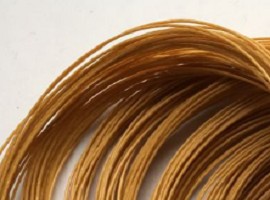 It’s the fastest growing string on the market and has become very popular among ATP players and some WTP players. It’s not known to deliver much power and outstanding feel but its development of co-polyester modules has made improvement in tension maintenance and feel making it less harsh now.
It’s the fastest growing string on the market and has become very popular among ATP players and some WTP players. It’s not known to deliver much power and outstanding feel but its development of co-polyester modules has made improvement in tension maintenance and feel making it less harsh now.
Its relatively less power generation compared to that of nylon or natural guts trades it for an exceptional spin creation. It’s a very durable string specially engineered for string breakers and players with aggressive play style.
When it comes to stringing, it’s easier in a hybrid. If you have arm issues or at a beginner level, it’s not the best choice for you. But if you want to try it, use it in a hybrid with other material strings.
Aramid Tennis Strings, Fantastic Abrasion Resistance
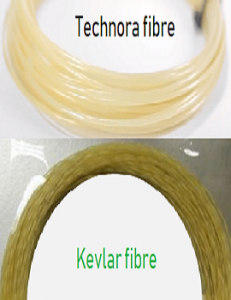 They are strings made from fibres which are more durable, stiffer and provide better control of high tensions on racquets. They are by far stiffer than nylon strings and mostly come as multifilament strings with some amount of nylon embeddings.
They are strings made from fibres which are more durable, stiffer and provide better control of high tensions on racquets. They are by far stiffer than nylon strings and mostly come as multifilament strings with some amount of nylon embeddings.
Its stiffness provides better control at the expense of power due to low deflection of racquet string bed on impact with the ball. This makes it a good option for big hitters who seek maximum control rather than more power in the game.
In stringing with aramid strings, it’s advisable to lower the tension by 10% than you would normally use. It’s not a better option for players who are at the beginner level or have problems with their arms to use on full beds. But stringing it in hybrids with natural gut or nylon at the crosses will be fine.
Under this string, you will find DuPont Kevlar fibre and Technora fibre.
Modes of String Construction – Does it Affect Performance of strings?
The way strings are manufactured contributes to the string’s performance as much as the string material does. So, the type you go in for is essential for your selection. There are:
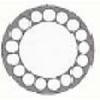
Solid Core with One Outer Wrap: Nylon strings are popularly known by this construction. The strategic design of nylon at the centre with nicely sized and calculated alignment of wraps at the outer surface provides the benefit of improved tension maintenance and awesome feel.
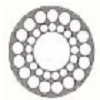 Solid Core with Multiple Wraps: It has a number of wraps around the solid core and offers added property of durability as well as cushioning effect. You get a maximum feel with the racquet when you strike the ball.
Solid Core with Multiple Wraps: It has a number of wraps around the solid core and offers added property of durability as well as cushioning effect. You get a maximum feel with the racquet when you strike the ball.
 Monofilament Polyester: It’s mostly used for polyester strings and offers a great deal of durability. It’s relatively less stiff than Kevlar constructed string except for its dead feel. It’s recommended for players who break their strings often.
Monofilament Polyester: It’s mostly used for polyester strings and offers a great deal of durability. It’s relatively less stiff than Kevlar constructed string except for its dead feel. It’s recommended for players who break their strings often.
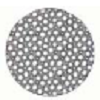 Multifilament with No Wraps: Unlike the solid cores, this has rolls of tiny synthetic fibres clumped together to offer improved cushioning effect. It’s more comfortable than the solid core of nylon. It’s also soft and makes a good choice for players with problems with the arm but can’t afford the natural gut.
Multifilament with No Wraps: Unlike the solid cores, this has rolls of tiny synthetic fibres clumped together to offer improved cushioning effect. It’s more comfortable than the solid core of nylon. It’s also soft and makes a good choice for players with problems with the arm but can’t afford the natural gut.
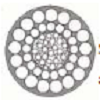 MultiCore with Wraps: It has smaller diameter bundles of microfibre core with one or more outer wraps. It’s not much different from the multifilament (no wraps) except for the improved durability.
MultiCore with Wraps: It has smaller diameter bundles of microfibre core with one or more outer wraps. It’s not much different from the multifilament (no wraps) except for the improved durability.
 Textured: It has a solid core with wrapping. The only difference is the embedding of filaments in the outer wraps or on the surface of the wraps. This configuration enhances the string’s spin potential.
Textured: It has a solid core with wrapping. The only difference is the embedding of filaments in the outer wraps or on the surface of the wraps. This configuration enhances the string’s spin potential.
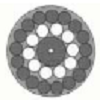 Composites: it’s formed by blending different materials of unique properties together with the aim of maximizing them. It’s to incorporate a uniform mixture exceptional characteristic.
Composites: it’s formed by blending different materials of unique properties together with the aim of maximizing them. It’s to incorporate a uniform mixture exceptional characteristic.
Credits: Images under modes of construction were obtained from tennis warehouse.
What Else Do I Look For?
You might be wondering why you need to know all this information just to find a right string for your racquet. Tennis string is important as the engine of a car. Most people fail to consider that until it disappoints them on the court.
Among the several grading categories, below are few to take note of:
String Gauge
It refers to the diameter of the string. The thinner the string the better its playability whiles durability is associated with its thickness. Per the naming system, the thickest is 15 and the thinnest is 19 and sometimes 20. When L is attached to the value it implies half gauge where the L means “light”.
So, a string specified as 16L means its thinner than 16 but thicker than 17. Generally, thinner strings are known to generate more spin.
String Gauges and Diameters in millimetres:
| 15 | = | 1.41 – 1.49 mm | 17 | = | 1.20 – 1.24 mm |
| 15L | = | 1.34 – 1.40 mm | 17L | = | 1.16 – 1.20 mm |
| 16 | = | 1.26 – 1.33 mm | 18 | = | 1.10 – 1.16 mm |
| 16L | = | 1.22 – 1.26 mm | 19 | = | 1.00 – 1.10 mm |
Playability
This has to do with the overall quality of the string and the ease with which you unleash that in your game. In addition, it’s how fast your string snaps back to its original position after hitting a ball, that is how resilient the string is.
It’s influenced by the material of the string, its construction and gauge. Natural guts are unmatched in resilience and still continues to carry the baton. Some popular strings you can check are Babolat X-Cel, Tecnifibre NRG2, Wilson Sensation NXT and other few.
Durability
We’re easily attempted to buy things which are tagged durable. In the tennis game, durability is inversely related to playability – so, going in for a very durable one will be sacrificing playability.
Hence, a player who easily breaks strings – for example, a 16L gauge string will do himself good by switching to the 16 gauge version of that string. Strings like Babolat and other popular versions of Luxilon strings offer a reliable durability.
Tension
It’s a secret weapon to power generation and having control over your shots. Generally, more power generating racquets would have relatively loose strings (lower tension) whiles higher tension strings offer better control over shots.
For advanced players with fast, aggressive swings often need more control and thus tighter strings are helpful. However, a beginner player in which control is essential doesn’t necessarily need a high-tension string but a lower one to be able to frequently hit balls at the centre of the racquet.
You’re to note that every racquet and the recommended tension range specified by the manufacturer as result of their playtesting.
Power
As most players would like their shots to drop like bombshells (with great power), it is advisable to find your best string tension setting to get a perfect blend of power and control.
But if you want more power then drop your tension by a few pounds. Lower tension not only gives you more power but reduces arm injuries. That’s vibrations transmitted to your hand and elbow anytime you hit the ball.
Summary
Up to this point, you have a handful information to help you decide on what type of string to go for. Having the right information is a great resource to discovering the best string for your racquet. Let me have your comment if this article is helpful to you or if you have a question and I will be glad to get back to you.
Now that you can make a good choice, you need to know how often to replace it. Check it out here. For a more detailed information on the top rated strings to consider for your racquet, click here.


What a really great article – I used to play tennis when I was younger and all the people who play today will love this site as it is so informative
Thank you
I’m glad you’ve gotten something out of it. I will be grateful if you can share with them. Thanks
I can see you are an expert when it comes to tennis and tennis equipment. I was curious about what tennis string fits my playstyle because I am an aggressive player and I broke a lot of stings. I was nonchalant whenever I went to replace the broken string. The guy at the shop did ask me which type but I said “any.” The guy probably took advantage of my ignorance, and because of it I was his regular customer 🙂 Now, thanks to your informative post I will not be a fool anymore! I think I’ll go with polyester based string.
All the best,
Ivan
Hello Ivan,
Having the right information is a great weapon. I’m glad you’re now confident to choose your own string. Enjoy your game!
It’s a pity I’m not a tennis fan, you really know your stuff.
Hi Dwayne,
Thanks for the compliment. You can come around anytime to get some titbits.